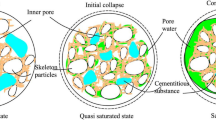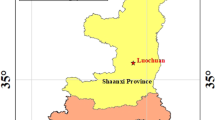Abstract
As a major engineering material, loess has complex structure and properties. This complexity is manifested in the open metastable packing structure and collapsibility, thereby causing considerable trouble to the environment and human habitation. Several scholars have attempted to reveal the nature of loess. Its structure was investigated using scanning electron microscopy, and the collapsibility was observed in in-suit and laboratory. Results indicate that there is a close relationship between loess collapsibility and structure. Loess collapsibility is the destruction of its metastable structure. Given limited experimental equipment and methods, observing the changes in particle arrangement directly before and after humidification in the same area is difficult. Therefore, the mechanism of loess collapsibility is mainly summarized from experimental observation data or reasonable speculation. In this work, we observed the specific movement and changes of particles in the same area by fixing certain sites in an environment scanning electron microscope of these samples. Six samples were prepared at the beginning of the experiment, and the special sites were fixed at each sample. During the observation we found that three samples could not efficaciously perform micrography efficaciously because the uneven electron conduction excessively brightened the particles to be observed. The three other samples dropped water carefully for humidification in the following 5 days, and the fixed sites were re-observed in the ESEM for the second time. Results showed that loess collapsibility is a macroscopic manifestation under the change in intergranular cementation. In addition, intergranular cement would not completely disappear during once humidification process. By contrast, along with the movement of water, the cement can regroup in an appropriate place and bind the particles until the next humidification process. This condition also causes loess to collapse in every humidification process. This phenomenon has been frequently overlooked by many scholars.














Similar content being viewed by others
References
Assadi-Langroudi A, Ng’ambi S, Smalley I (2018) Loess as a collapsible soil: some basic particle packing aspects. Quatern Int 469:20–29. https://doi.org/10.1016/j.quaint.2016.09.058
Bai XH, Ma FL, Wang M, Jia JG (2015) Micro-structure and collapsibility of loess in China. Crc Press-Taylor & Francis Group, Boca Raton
Barden L, McGown A, Collins K (1973) The collapse mechanism in partly saturated soil. Eng Geol 7:49–60
Bultreys T, De Boever W, Cnudde V (2016) Imaging and image-based fluid transport modeling at the pore scale in geological materials: a practical introduction to the current state-of-the-art. Earth-Sci Rev 155:93–128. https://doi.org/10.1016/j.earscirev.2016.02.001
Cheng YX, Huo AD, Zhang J, Lu YD (2015) Early warning of meteorological geohazard in the Loess Plateau: a study in Huangling County of Shaanxi Province in China. Environ Earth Sci 73:1057–1065. https://doi.org/10.1007/s12665-014-3455-7
Darbari Z, Jaradat KA, Abdelaziz SL (2017) Heating-freezing effects on the pore size distribution of a kaolinite clay. Environ Earth Sci 76:8. https://doi.org/10.1007/s12665-017-7069-8
Deng J, Wang LM, Zhang ZZ, Bing H (2010) Microstructure characteristics and forming environment of late quaternary period loess in the loess plateau of China. Environ Earth Sci 59:1807–1817. https://doi.org/10.1007/s12665-009-0162-x
Gao GR (1980) The microstructure of loess in China. Chin Sci Bull 25:945–948 (in Chinese)
Gao GR (1984) Microstructure of loess soil in China relatiive to geographic and geology environment. Acta Geol Sinica 58:265–270 (in Chinese)
Jiang MJ, Zhang FG, Hu HJ, Cui YJ, Peng JB (2014) Structural characterization of natural loess and remolded loess under triaxial tests. Eng Geol 181:249–260. https://doi.org/10.1016/j.enggeo.2014.07.021
Jin MX (2006) Effects of moistening and demoistening of collapsible loess. Geotech Eng Tech 20:203–207 (in Chinese)
Klukanova A, Sajgalik J (1994) Changes in loess fabric caused by collapse: an experimental study. Quat Int 24:35–39. https://doi.org/10.1016/1040-6182(94)90036-1
Lei XY (1983) The type of microstructure of loess in Xi’an. JNWU 13:56–65; 127–132 (in Chinese)
Lei XY (1987) The pore type and collapsibility of loess in China. Sci Sin (episodes B) 17:1309–1318 (in Chinese)
Leng YQ, Peng JB, Wang QY, Meng ZJ, Huang WL (2017) A fluidized landslide occurred in the Loess Plateau: a study on loess landslide in South Jingyang tableland. Eng Geol 236:129–136. https://doi.org/10.1016/j.enggeo.2017.05.006
Li XA, Li LC (2017) Quantification of the pore structures of Malan loess and the effects on loess permeability and environmental significance, Shaanxi Province, China: an experimental study. Environ Earth Sci 76:14. https://doi.org/10.1007/s12665-017-6855-7
Li P, Vanapalli S, Li TL (2016) Review of collapse triggering mechanism of collapsible soils due to wetting. J Rock Mech Geotech Eng 8:256–274. https://doi.org/10.1016/j.jrmge.2015.12.002
Li PY, He S, He XD, Tian R (2017) Seasonal hydrochemical characterization and groundwater quality delineation based on matter element extension analysis in a paper wastewater irrigation area, Northwest China. Expos Health 9:1–18. https://doi.org/10.1007/s12403-017-0258-6
Li PY, He X, Li Y, Xiang G (2018a) Occurrence and health implication of fluoride in groundwater of loess aquifer in the Chinese Loess Plateau: a case study of Tongchuan, Northwest China. Expos Health. https://doi.org/10.1007/s12403-018-0278-x
Li PY, Qian H, Wu J (2018b) Conjunctive use of groundwater and surface water to reduce soil salinization in the Yinchuan Plain, North-West China. INT J Water Resour D 34:337–353. https://doi.org/10.1080/07900627.2018.1443059
Liu Z, Liu FY, Ma FL, Wang M, Bai XH, Zheng YL, Yin H, Zhang GP (2016) Collapsibility, composition, and microstructure of loess in China. Can Geotech J 53:673–686. https://doi.org/10.1139/cgj-2015-0285
Ma Y, Zhong NN, Huang XY, Guo ZP, Yao LP (2014) The application of focused ion beam scanning electron microscope (FIB-SEM) to the nanometer-sized pores in shales. J Chin Electron Microsc Soc 33:251–256 (in Chinese)
Ma FL, Yang J, Bai XH (2017) Water sensitivity and microstructure of compacted loess. Transp Geotech 11:41–56. https://doi.org/10.1016/j.trgeo.2017.03.003
Matyas EL, Radhakrishna HS (1968) Volume Change Characteristics of Partially Saturated Soils. Géotechnique 18:432–448. https://doi.org/10.1680/geot.1968.18.4.432
Peng JB, Wang GH, Wang QY, Zhang FY (2017) Shear wave velocity imaging of landslide debris deposited on an erodible bed and possible movement mechanism for a loess landslide in Jingyang, Xi’an, China. Landslides 14:1503–1512. https://doi.org/10.1007/s10346-017-0827-6
Rogers CDF, Dijkstra TA, Smalley IJ (1994) Hydroconsolidation and subsidence of loess Studies from China, Russia, North America and Europe. Eng Geol 37:83–113
Shao X, Zhang H, Tan Y (2018) Collapse behavior and microstructural alteration of remolded loess under graded wetting tests. Eng Geol 233:11–22. https://doi.org/10.1016/j.enggeo.2017.11.025
Sun DA, Matsuoka H (2004) Collapse Behavior of Compacted Clays in Suction-Controlled Triaxial Tests. Geotech Test J 27:362–370. https://doi.org/10.1520/GTJ11418
Sun DA, Sheng D, Xu Y (2007) Collapse behaviour of unsaturated compacted soil with different initial densities. Can Geotech J 44:673–686
Taillon JA, Pellegrinelli C, Huang Y-L, Wachsman ED, Salamanca-Riba LG (2018) Improving microstructural quantification in FIB/SEM nanotomography. Ultramicroscopy 184:24–38. https://doi.org/10.1016/j.ultramic.2017.07.017
Terzaghi K (1943) Theoretical soil mechanics. Wiley, New York
Vanapalli SK, Fredlund DG, Pufahl DE (1999) The influence of soil structure and stress history on the soil–water characteristics of a compacted till. Geotechnique 51:573–576. https://doi.org/10.1680/geot (1999.49.2.143)
Wang HN, Ni WK (2012) Quantitative analysis of loess microstructure based on CT and SEM images. Rock Soil Mech 33:243–248 (in Chinese)
Wu JH, Li PY, Qian H (2015) Hydrochemical characterization of drinking groundwater with special reference to fluoride in an arid area of China and the control of aquifer leakage on its concentrations. Environ Earth Sci 73:8575–8588. https://doi.org/10.1007/s12665-015-4018-2
Xie W, Li P, Vanapalli SK, Wang J (2018) Prediction of the wetting-induced collapse behaviour using the soil-water characteristic curve. J Asian Earth Sci 151:259–268. https://doi.org/10.1016/j.jseaes.2017.11.009
Xu L, Dai FC, Gong QM, Tham LG, Min H (2012) Irrigation-induced loess flow failure in Heifangtai Platform, North-West China. Environ Earth Sci 66:1707–1713. https://doi.org/10.1007/s12665-011-0950-y
Yuan ZX, Wang LM (2009) Collapsibility and seismic settlement of loess. Eng Geol 105:119–123. https://doi.org/10.1016/j.enggeo.2008.12.002
Zhang M, Liu J (2010) Controlling factors of loess landslides in western China. Environ Earth Sci 59:1671–1680. https://doi.org/10.1007/s12665-009-0149-7
Zhang YS, Qu YX (2005) Cements of sand loess and their cementation in North Shaanxi and West Shanxi. J Eng Geol 13:18–28. https://doi.org/10.3969/j.issn.1004-9665.2005.01.003 (in Chinese)
Zhang SM, Zhang W (1992) The collapsibility of loess during humidification and dehumidification. Chin J Geotech Eng 14:57–61 (in Chinese)
Zhang SM, Zheng JG (1990) The deformation characteristics of collapsible loess during moistening process. Chin J Geotech Eng 12:21–31 (in Chinese)
Acknowledgements
This work was financially supported the Key program of National Natural Science Foundation of China (Grant No. 41630634) and the Innovation Group and Major Research Project of the Education Department of Guizhou Province (Grant No. QJH-KY [2016]054, QJH-KY [2016]055).
Author information
Authors and Affiliations
Corresponding author
Additional information
Publisher's Note
Springer Nature remains neutral with regard to jurisdictional claims in published maps and institutional affiliations.
Rights and permissions
About this article
Cite this article
Zhang, X., Lu, Y., Li, X. et al. Microscopic structure changes of Malan loess after humidification in South Jingyang Plateau, China. Environ Earth Sci 78, 287 (2019). https://doi.org/10.1007/s12665-019-8290-4
Received:
Accepted:
Published:
DOI: https://doi.org/10.1007/s12665-019-8290-4




